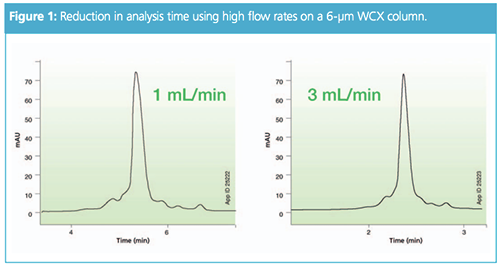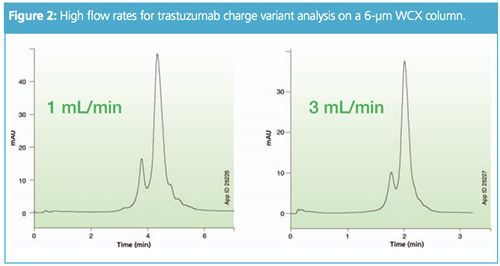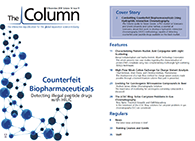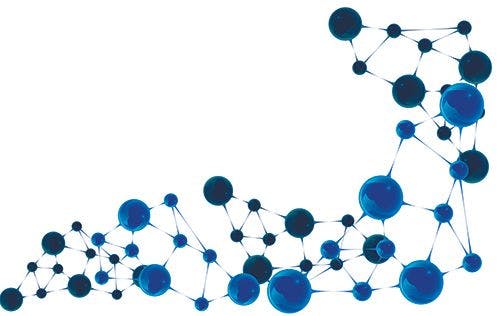High-Flow Weak Cation Exchange for Charge Variant Analysis
The Column
Within the broad scope of analytical techniques required to characterize a protein, chromatographic methods have shifted towards high-flow analyses that can drop development time significantly. However, fast analytical methods for charge heterogeneity have lagged in development because current column technologies are ultrahigh-pressure liquid chromatography (UHPLC)-incompatible. This article will demonstrate the development of a high-flow method for charge variant analysis made possible through a bioinert titanium column flow path.
Photo Credit: nongkran_ch/stock.adobe.com

Within the broad scope of analytical techniques required to characterize a protein, chromatographic methods have shifted towards high-flow analyses that can drop development time significantly. However, fast analytical methods for charge heterogeneity have lagged in development because current column technologies are ultrahigh-pressure liquid chromatography (UHPLC)-incompatible. This article will demonstrate the development of a high-flow method for charge variant analysis made possible through a bioinert titanium column flow path.
As pressure increases for biopharmaceutical companies to reduce their drug development timelines, more rapid and robust methods to produce biotherapeutics are required. Unlike small molecule therapeutics, each recombinant generation of protein therapeutics creates the added complexity of post-translational modifications (PTMs). These PTMs include differing glycosylation patterns, oxidized and deamidated species, as well as fragmentation, among others. The full characterization of a monoclonal antibody (mAb) is extensive and uses a variety of analytical techniques including high performance liquid chromatography (HPLC), capillary isoelectric focusing (cIEF), circular dichroism (CD), and mass spectrometry (MS). Because of the variation with each mAb, quick assessment of the batch is a critical need. Many analytical techniques have made technological advances in recent years to speed up analysis time, and as an example, ultrahighâpressure liquid chromatography (UHPLC) has facilitated the decrease in data acquisition time. However, one area that has lagged in chromatography development is cation exchange chromatography (CEX) for charge variant analysis. Polyether ether ketone (PEEK) is the most common column hardware for CEX, however, variations in column inner diameter and low pressure limitations render it incapable of consistent UHPLC applications. Recent advances in column hardware to incorporate a titanium flow path have circumvented the limitations of rapid charge variant assessment by CEX. This study demonstrates a high flow solution for weak cation exchange chromatography (WCX) using a bioinert titanium column.
Methods
Sodium phosphate monobasic, sodium phosphate dibasic, and 2-(N-morpholino)ethanesulfonic acid (MES) hydrate were purchased from Sigma Aldrich. Sodium chloride was purchased from VWR. Sodium hydroxide was purchased from Fisher Scientific. Trastuzumab and rituximab were purchased from Myoderm. A 50 mm × 4.6 mm, 6-µm bioZen WCX column (Phenomenex) was used for all ion exchange separations. All samples were analyzed on an Agilent 1260 HPLC with a chilled autosampler and variable wavelength detector set at 280 nm; data were collected using ChemStation software (Agilent). The mobile phases for ion exchange separation chromatography were 20-mM MES pH 5.9 and 20 mM MES 300 mM NaCl pH 5.9.
Results and Discussion
Charge heterogeneity in monoclonal antibodies resulting from PTMs is a critical quality attribute that must be assessed throughout the drug development process. One of the more common methods to assess charge variants in mAbs is with cIEF, but there are limitations with robustness, cost, and broad utility. HPLC solutions for charge heterogeneity are preferred and are often used for fractionation and collection during full characterization. During other areas of development, such as clone selection and process analytical technology, a more rapid analysis of charge variants is desirable because of high sample counts and real-time monitoring requirements. Further, accurate charge heterogeneity determination of the intact protein is ideal because it avoids a reduction step. The nature of protein charge variants means that a bioinert column flow path is necessary as a traditional stainless steel column will adsorb charged species and thus alter the results of the analysis. Therefore, PEEK columns are beneficial because of their biocompatibility. The drawbacks of PEEK columns are the pressure limitations and column variability from the inherent variance in column inner diameter. Titanium-infused stainless steel is another method to make a bioinert flow path and is suitable for bioinert LC systems because it allows high flow options while still maintaining biocompatibility for charge variant analysis.

Rapid assessment of charge variants on an intact protein requires sufficient separation of acidic and basic variants from the main, neutral peak. To speed up the analysis, a 50 mm column length is preferable if separation is still attainable. For example, at 1 mL/min flow rate, the separation of rituximab provided 17% acidic and 10% basic variants (Figure 1). Increasing the flow to 3 mL/min gave 15% acidic and 12% basic variants. With weak cation exchange, the particle surface is typically a polycarboxylate that can bind to protein variants through electrostatic charge interactions. A main reason the resolution of acidic and basic variants is not changed at a higher flow rate is because the polycarboxylate surface allows for a bind and elute type mechanism, which is less dependent on flow rate and more so on the charge density of the protein as well as interacting area between the protein and stationary phase (1). Of course, the main overall advantage is that the analysis time is reduced from 12 min to 6 min with minimal impact on the quantitative assessment of variants. Figure 2 demonstrates the same increase in analysis time of trastuzumab charge heterogeneity with minimal impact on acidic and basic variants. At both 1 mL/min and 3 mL/min, 19% acidic and 11% basic variants were observed for both flow rates. Flow rates higher than 3 mL/min began to erode the acidic and basic variant results.

The pressure increases at high flow rates can limit the standard PEEK hardware in ion exchange analysis. Using bioinert titanium columns minimized this pressure restriction. For example, the above analyses performed at 1 mL/min reached a back pressure of 1160 psi, whereas the 3 mL/min runs gave 3530 psi back pressure. While experiments at 5 mL/min started to decrease acidic and basic variant detection, a back pressure of 6130 psi with no impact on column integrity was observed. While not technically within the pressure window of UHPLC columns, the titanium-infused stainless steel columns provide a significant pressure threshold increase compared to PEEK columns.
Conclusion
The rapid assessment of protein charge variants has advantages in many analytical areas in biotherapeutic development. While the movement of the industry towards modern UHPLC chromatographic techniques has progressed in analytical development, ion exchange chromatography has been slow to follow because of the requirement of bioinert column hardware. Titanium-based columns can withstand higher pressures than traditional PEEK columns, and thus higher flow rates are attainable. As a result of the bind-elute mechanism of cation exchange chromatography, the flow rate can be increased to 3 mL/min on short 50-mm columns with minimal impact on the results of charge heterogeneity. These combined factors demonstrate titanium-based columns are suitable for analytical scientists seeking rapid charge variant analysis.
Reference
- J. Ståhlberg and J. Bengt, Analytical Chemistry68(9), 1536–1544 (1996).
Chad Eichman received his B.S. in chemistry from the University of Wisconsin-Madison (USA) and his Ph.D. in organic chemistry from The Ohio State University (USA). After a postdoctoral appointment at Northwestern University (USA) and an assistant professorship at Loyola University Chicago (USA), Chad joined Phenomenex, Inc. as the Global Biopharmaceutical Market Manager. His current role is focused on supporting the development of analytical solutions for biologics analysis.
Brian Rivera received his B.S. in genetics from the University of California, Davis (USA). He then went into the biotechnology industry, mainly performing analytical method development for protein characterization. Brian joined Phenomenex as Technical Specialist, then moved into product management, focusing on the development of LC columns for separation of biologics and other large molecules.
Christina Malinao received her B.S. in neuroscience and biology from the University of California, Riverside (USA). She spent some time at Schering Plough performing biomarker characterization, and several years at Agensys performing antibody and antibody–drug conjugate characterization. She joined Phenomenex as a scientist in their PhenoLogix laboratory and works on developing methods for LC and sample preparation products.
E-mail:chade@phenomenex.comWebsite:www.phenomenex.com/bioZen

Accelerating Monoclonal Antibody Quality Control: The Role of LC–MS in Upstream Bioprocessing
This study highlights the promising potential of LC–MS as a powerful tool for mAb quality control within the context of upstream processing.
New Study Reviews Chromatography Methods for Flavonoid Analysis
April 21st 2025Flavonoids are widely used metabolites that carry out various functions in different industries, such as food and cosmetics. Detecting, separating, and quantifying them in fruit species can be a complicated process.

.png&w=3840&q=75)

.png&w=3840&q=75)



.png&w=3840&q=75)



.png&w=3840&q=75)













